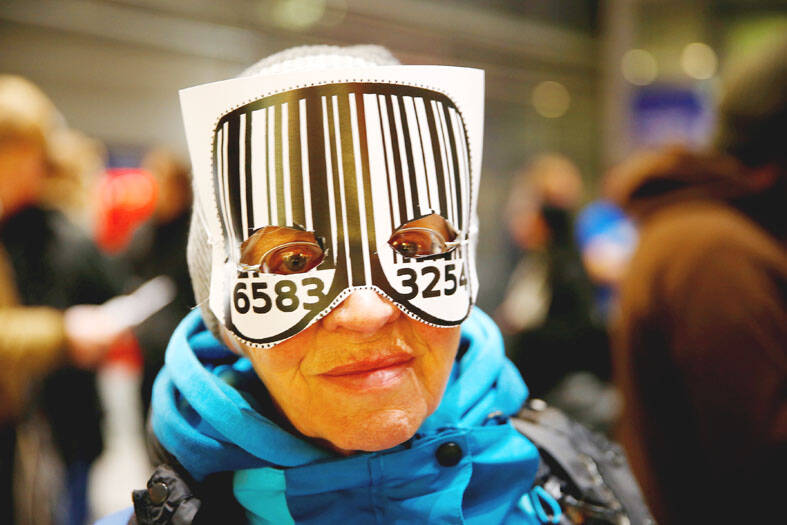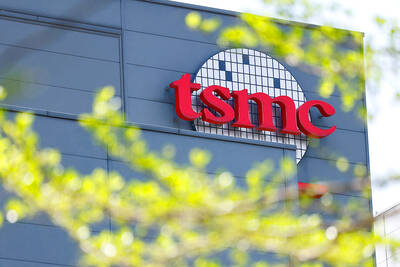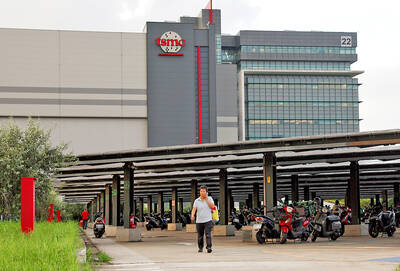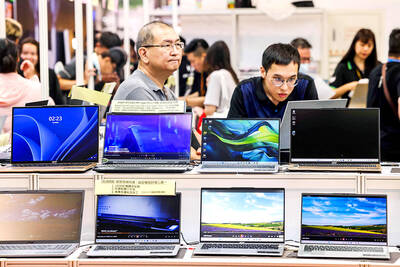The patch of irregular vertical lines that revolutionized checking out at the supermarket and facilitated the globalization of retail is turning 50.
However, as the barcode celebrates its birthday, its days might be numbered, as it faces competition from the younger QR code, the information-filled squares used by smartphones.
The trademark beep as a product is scanned is heard about 6 billion times per day across the world, as about 70,000 items are sold each second.

Photo: Reuters
It has become so integrated in the shopping experience that it is easy to forget how much the technology revolutionized retail by speeding up the checkout process and giving retailers the ability to trace products and better manage inventory.
The barcode not only identifies a product, but “gives professionals in stores access to other functionalities,” said Laurence Vallana, country manager for France at SES-Imagotag SE, a company that specializes in electronic tagging.
Barcodes were initially patented by engineers Norman Joseph Woodland and Bernard Silver in the US in 1952.
However, it was not until nearly two decades later, in 1971, that US engineer George Laurer perfected the technology and moves toward its commercialization began.
On April 3, 1973, the standard to identify products was agreed by a number of large retailers and food companies. It later became known as EAN-13, which stands for European Article Number and the number of digits in the barcode.
The following year, on June 26, the first product was scanned: a pack of chewing gum sold in Ohio that is now in the National Museum of American History in Washington. Today, non-governmental organization Global Standard 1 (GS1) manages the barcode system and counts about 2 million firms as members.
It provides companies with a unique “global trade item number” for each product, which is then translated into the barcode. Each firm must pay an annual fee based on their sales, up to nearly US$5,000 per year.
However, the humble barcode will soon give way to another standard developed by the organization, said Renaud de Barbuat and Didier Veloso, the respective heads of GS1 Global and GS1 France.
The new standard, based on QR, or Quick Response code, is likely to be introduced in 2027.
If barcodes have been compared to prison bars by critics of the overcommercialization of society, the Chinese game go with its white and black pieces on a square board was the inspiration for the QR code’s Japanese creator, Masahiro Hara.
Developed in 1994, QR codes can hold much more information as they are read horizontally, like barcodes, as well as vertically.
Instead of having to search a database for information to go along with a product, the QR code can integrate information directly, such as the composition of the product and recycling instructions.
GS1 believes moving to the QR code format allows sharing far more information about products and content, enabling new uses that would be accessible to consumers and retailers.
As smartphones can read QR codes, they are an easy way to send people to Web sites to get additional information, leading to their widespread adoption by companies, artists and even museums. They are even used by payment systems.
However, barcodes are likely to remain in place for years to come as the world gradually transitions to QR codes.

TECH TITAN: Pandemic-era demand for semiconductors turbocharged the nation’s GDP per capita to surpass South Korea’s, but it still remains half that of Singapore Taiwan is set to surpass South Korea this year in terms of wealth for the first time in more than two decades, marking a shift in Asia’s economic ranks made possible by the ascent of Taiwan Semiconductor Manufacturing Co (TSMC, 台積電). According to the latest forecasts released on Thursday by the central bank, Taiwan’s GDP is expected to expand 4.55 percent this year, a further upward revision from the 4.45 percent estimate made by the statistics bureau last month. The growth trajectory puts Taiwan on track to exceed South Korea’s GDP per capita — a key measure of living standards — a

READY TO HELP: Should TSMC require assistance, the government would fully cooperate in helping to speed up the establishment of the Chiayi plant, an official said Taiwan Semiconductor Manufacturing Co (TSMC, 台積電) yesterday said its investment plans in Taiwan are “unchanged” amid speculation that the chipmaker might have suspended construction work on its second chip packaging plant in Chiayi County and plans to move equipment arranged for the plant to the US. The Chinese-language Economic Daily News reported earlier yesterday that TSMC had halted the construction of the chip packaging plant, which was scheduled to be completed next year and begin mass production in 2028. TSMC did not directly address whether construction of the plant had halted, but said its investment plans in Taiwan remain “unchanged.” The chipmaker started

MORTGAGE WORRIES: About 34% of respondents to a survey said they would approach multiple lenders to pay for a home, while 29.2% said they would ask family for help New housing projects in Taiwan’s six special municipalities, as well as Hsinchu city and county, are projected to total NT$710.65 billion (US$23.61 billion) in the upcoming fall sales season, a record 30 percent decrease from a year earlier, as tighter mortgage rules prompt developers to pull back, property listing platform 591.com (591新建案) said yesterday. The number of projects has also fallen to 312, a more than 20 percent decrease year-on-year, underscoring weakening sentiment and momentum amid lingering policy and financing headwinds. New Taipei City and Taoyuan bucked the downturn in project value, while Taipei, Hsinchu city and county, Taichung, Tainan and Kaohsiung

Micro-Star International Co (MSI, 微星科技) is expanding notebook computer production in India after partnering with Indian electronics maker Syrma SGS Technology Ltd late last year, as the Taiwanese company seeks to tap into the local market. MSI also plans to manufacture some of its new gaming PCs powered by Nvidia Corp’s RTX 50 graphics cards in India, while adding more advanced and design-focused PCs and notebooks at Syrma’s plant in Chennai, a source told the Taipei Times yesterday on condition of anonymity. MSI’s deployment in India is driven not only by cost advantages, but also by India’s rapidly expanding consumer market and